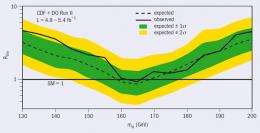Fig. 1. The ratio (Rlim) of the excluded Higgs production cross-section over the theoretical Standard Model cross-section. The mass range where the observed curve falls below one is excluded at the 95% confidence level.
Almost a decade after the experiments at CERN’s Large Electron-Positron (LEP) collider set a limit on the mass of the Higgs boson of 114.4 GeV/c2, the two experiments at Fermilab’s Tevatron, CDF and D0 have been able to reduce further the allowed mass range for the missing particle in their first joint Run II publication.
In the proton-antiproton collisions observed at the Tevatron, the Higgs boson could be produced in the fusion of two gluons. If its mass is more than 140 GeV/c2, it will usually decay into a pair of W bosons. The decay of the W bosons into a charged lepton (electron or muon) and a neutrino leads to three different signatures in the detectors: two electrons, two muons or an electron and a muon, in addition to “missing energy" from the undetected neutrinos. This is the key to reducing the background from the jets, which are copiously produced in hadronic collisions.
The Higgs boson is a scalar particle, i.e. it carries no spin. This fundamental property helps to distinguish the decays of the Higgs to two W bosons from other events that contain pairs of W bosons. The two charged leptons from the W boson decays in Higgs events are more likely to be close together than back-to-back in the detector. As a final step in seeking the Higgs, artificial neural networks are trained to distinguish a Higgs signal from background using a large number of kinematic variables.
Both Tevatron experiments have their best sensitivity at a Higgs mass of about 165 GeV/c2, i.e. just around the combined mass of the two W bosons. With about 5 fb-1 of collision data analysed, each experiment alone does not yet have sensitivity to exclude a Higgs boson if it is produced at the rate predicted by the Standard Model. Putting their data together, CDF and DŘ can double the number of collisions used, breaking the “Standard Model barrier" for the first time since LEP.
Together, the experiments would expect about 70 Higgs events for a mass of around 165 GeV/c2 but their combined data are consistent with the assumption that no Higgs events have been produced. This observation is translated into a limit that excludes a Higgs boson in the mass range 162-166 GeV/c2 at the 95% confidence level.
The paper describing the combination is the first joint publication of the two collaborations using data from Run II of the Tevatron, which started in 2001. The publication, with 1042 authors, will appear in Physics Review Letters together with the individual results in separate letters. The data used represent about half the number of collisions that will eventually be recorded by CDF and DŘ. This will give them the opportunity to increase significantly the sensitivity of Higgs searches in the future.
Together with the precision electroweak data that favour a low-mass Higgs boson, these new results indicate that the most likely mass for the Higgs boson - if it exists - is somewhere between the LEP and Tevatron limits of 114 and 162 GeV/c2.
More information:
Further reading
CDF and DŘ Collaboration, arXiv:1001.4162, accepted by Phys. Rev. Lett.
CDF Collaboration, arXiv:1001.4468, accepted by Phys. Rev. Lett.
DŘ Collaboration, arXiv:1001.4481, accepted by Phys. Rev. Lett.
Source: CERN






















